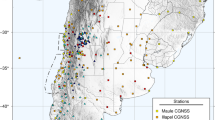Abstract
Gravity anomalies illuminate subsurface lithology and geological structure in three dimensions, which is vital for studies of concealed faults, sedimentary basins, basement lithology, and other geological targets. Although not all geological contacts correspond to lithological contacts, the contact mapping provides key information on structural regimes, deformation styles and trends. Many techniques for contact mapping have been developed. Here, we evaluate five methods applied to gridded data. The first two are the horizontal gradient magnitude of the gravity field (GF hgm), and tilt (TI hgm). The third and fourth rely on locating maxima of the analytic signal (AS) and the 3D local wavenumber (LW). The fifth is normalized standard deviation (NSTD) method. In this article, we evaluate the use of these five methods for mapping contacts and compare the results. First, synthetic vertically-sided models are used to quantify the offsets of maxima from the true contact location due to the source effects of finite source thickness, central depth, and width. Second, the effects of contact dip are discussed. Finally, a real data set is used to evaluate the ability of each method to produce maps of coherent contact trends in the presence of noise and gridding artifacts.
Similar content being viewed by others
References Cited
Blakely, R. J., Simpson, R. W., 1986. Approximating Edges of Source Bodies from Magnetic or Gravity Anomalies. Geophysics, 51(7): 1494–1498
Cooper, G. R. J., Cowan, D. R., 2008. Edge Enhancement of Potential-Field Data Using Normalized Statistics. Geophysics, 73(3): H1–H4
Dentith, M., Cowan, D., Tompkins, L., 2000. Enhancement of Subtle Features in Aeromagnetic Data. Exploration Geophysics, 31(1–2): 104–108
Fedi, M., Florio, G., 2001. Detection of Potential Field Source Boundaries by Enhanced Horizontal Derivative Method. Geophysical Prospecting, 49(1): 40–58
Grauch, V. J. S., Cordell, L., 1987. Limitations of Determining Density or Magnetic Boundaries from the Horizontal Gradient of Gravity or Pseudogravity Data. Geophysics, 52(1): 118–121
Hsu, S. K., Sibuet, J. C., Shyu, C. T., 1996. High-Resolution Detection of Geologic Boundaries from Potential-Field Anomalies: An Enhanced Analytic Signal Technique. Geophysics, 61(2): 373–386
Li, X., 2006. Understanding 3D Analytic Signal Amplitude. Geophysics, 71(2): L13–L16
Liu, T. Y., 2007. New Data Processing Methods for Potential Field Exploration. Science Press, Beijing (in Chinese)
Liu, T. Y., Wu, Z. C., Zan, Y. L., et al., 2007. Wavelet Multi-scale Decomposition of Magnetic Anomaly and Its Application in Searching for Deep-Buried Minerals in Crisis Mines: A Case Study from Daye Iron Mines. Earth Science—Journal of China University of Geosciences, 32(1): 135–140 (in Chinese with English Abstract)
Li, Y. Y., Yang, Y. S., 2009. Derivative-Based Normalized Standard Deviation of Potential Field Data in Geological Contact Mapping. Geological Science and Technology Information, 28(5): 138–142 (in Chinese with English Abstract)
Miller, H. G., Singh, V., 1994. Potential Field Tilt-A New Concept for Location of Potential Field Sources. Journal of Applied Geophysics, 32(2–3): 213–217
Nabighian, M. N., 1972. The Analytic Signal of Two-Dimensional Magnetic Bodies with Polygonal Cross-Section: Its Properties and Use for Automated Anomaly Interpretation. Geophysics, 37(3): 507–517
Nabighian, M. N., 1984. Toward a Three-Dimensional Automatic Interpretation of Potential Field Data via Generalized Hilbert Transforms: Fundamental Relations. Geophysics, 49(6): 780–786
Phillips, J., 2000. Locating Magnetic Contacts: A Comparison of the Horizontal Gradient, Analytic Signal, and Local Wavenumber Methods. 70th Annual International Meeting, Society of Exploration Geophysics, Expanded Abstracts. Calgary, Canada. 402–405
Phillips, J. D., Hansen, R. O., Blakely, R. J., 2007. The Use of Curvature in Potential-Field Interpretation. Exploration Geophysics, 38(2): 111–119
Pilkington, M., 2007. Locating Geologic Contacts with Magnitude Transforms of Magnetic Data. Journal of Applied Geophysics, 63(2): 80–89
Pilkington, M., Keating, P., 2004. Contact Mapping from Gridded Magnetic Data-A Comparison of Techniques. Exploration Geophysics, 35(4): 306–311
Roest, W. R., Verhoef, J., Pilkington, M., 1992. Magnetic Interpretation Using the 3-D Analytic Signal. Geophysics, 57(1): 116–125
Smith, R. S., Thurston, J. B., Dai, T. F., et al., 1998. ISPI-The Improved Source Parameter Imaging Method. Geophysical Prospecting, 46(2): 141–151
Thurston, J. B., Smith, R. S., 1997. Automatic Conversion of Magnetic Data to Depth, Dip, and Susceptibility Contrast Using the SPI (TM) Method. Geophysics, 62(3): 807–813
Thurston, J. B., Smith, R. S., Guillon, J. C., 2002. A Multimodel Method for Depth Estimation from Magnetic Data. Geophysics, 67(2): 555–561
Verduzco, B., Fairhead, J. D., Green, C. M., et al., 2004. New Insights to Magnetic Derivatives for Structural Mapping. The Leading Edge, 23(2): 116–119
Author information
Authors and Affiliations
Corresponding author
Additional information
This study was supported by the Ph.D. Program Foundation of Ministry of Education of China for Distinguished Young Scholars (No. 200804911523), and the Research Foundation for Outstanding Young Teachers, China University of Geosciences (No. CUGQNL0726).
Rights and permissions
About this article
Cite this article
Li, Y., Yang, Y. & Liu, T. Derivative-based techniques for geological contact mapping from gravity data. J. Earth Sci. 21, 358–364 (2010). https://doi.org/10.1007/s12583-010-0099-8
Received:
Accepted:
Published:
Issue Date:
DOI: https://doi.org/10.1007/s12583-010-0099-8




